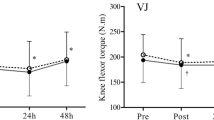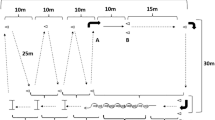Abstract
Short-term alactic anaerobic performance in jumping (5 consecutive jumps with maximal effort), sprint running (8 m) and stair climbing (modified Margaria test) were measured in 75 obese subjects (BMI: 40.3±5.0 kg/m2) and in 36 lean control subjects (BMI: 22.4±3.2 kg/m2) of the same age and gender distribution. The results show that obese subjects attained a significantly lower specific (per unit body mass) power output both in jumping (Wspec,j; p<0.001) and stair climbing (Wspec,s; p<0.001) and run at a significantly lower average velocity (v; p<0.001) during sprinting. In spite of the different motor skillfulness required to accomplish the jumping and climbing tests, Wspec,s (and hence the vertical velocity in climbing, vv) was closely correlated with Wspec,j (R2=0.427, p<0.001). In jumping, although the average force during the positive work phase was significantly higher in obese subjects (p<0.001), no difference between the 2 groups was detected in absolute power. In stair climbing the absolute power output of obese resulted significantly higher (18%) than that of lean controls (p<0.001). In sprint running, the lower average horizontal velocity attained by obese subjects also entailed a different locomotion pattern with shorter step length (Ls; p<0.001), lower frequency (p<0.001) and longer foot contact time with ground (Tc,r; p<0.001). Wspec,j seems to be a determinant of the poorer motor performance of obese, being significantly correlated with: I) the vertical displacement of the centre of gravity (R2=0.853, p<0.001) in jumping; II) with vv in stair climbing; and III) with Tc,r (R2=0.492, p<0.001), Ls (R2=0.266, p<0.001) and v (R2=0.454, p<0.001) in sprinting. The results suggest that obese individuals, although partially hampered in kinetic movements, largely rely on their effective specific power output to perform complex anaerobic tasks, and they suffer from the disproportionate excess of inert mass of fat. Furthermore, in view of the sedentary style of life and the consequent degree of muscle de-conditioning accompanying this condition, it may prove useful to implement rehabilitation programs for obesity with effective power training protocols.
Similar content being viewed by others
References
Flegal K.M. The obesity epidemic in children and adults: current evidence and research issues. Med. Sci. Sports Exerc. 1999, 31: S509–S514.
Mokdad A.H., Serdula M.K., Dietz W.H., Bowman B.A., Marks J.S., Koplan J.P. The continuing epidemic of obesity in the United States. J.A.M.A. 2000, 284: 1650–1651.
Di Pietro L. Physical activity in the prevention of obesity: current evidence and research issues. Med. Sci. Sports Exerc. 1999, 31: S542–S546.
Wing R.R. Physical activity in the treatment of adulthood overweight and obesity: current evidence and research issues. Med. Sci. Sports Exerc. 1999, 31: S547–S552.
Kraemer W.J., Volek J.S., Clark K.L., Gordon S.E., Puhl S.M., Koziris L.P., McBride J.M., Triplett-McBride N.T., Putukian M., Newton R.U., Häkkinen K., Bush J.A., Sebastianelli W.J. Influence of exercise training on physiological and performance changes with weight loss in men. Med. Sci. Sports Exerc. 1999, 31: 1320–1329.
Sartorio A., Narici M.V., Fumagalli E., Faglia G., Lafortuna C.L. Aerobic and anaerobic performance before and after a short-term body mass reduction program in obese subjects. Diab. Nutr. Metab. 2001, 14: 51–57.
Westerterp K.R. Obesity and physical activity. Int. J. Obes. Relat. Metab. Disord. 1999, 23 (Suppl. 1): 59–64.
Kitagawa K., Suzuki M., Miyashita M. Anaerobic power output of young obese men: comparison with non-obese men and the role of excess fat. Eur. J. Appl. Physiol. 1980, 43: 229–234.
Bosco C., Luhtanen P., Komi P.V. A simple method for measurement of mechanical power in jumping. Eur. J. Appl. Physiol. 1983, 50: 273–282.
Margaria R., Aghemo P., Rovelli E. Measurement of muscular power (anaerobic) in man. J. Appl. Physiol. 1966, 21: 1662–1664.
Zar J.H. Biostatistical analysis. Prentice-Hall International Editions, Eaglewood Cliffs, 1984, pp. 292–305.
Thomas E.L., Saeed N., Hajnal J.V., Brynes A., Goldstone A.P., Frost G., Bell J.D. Magnetic resonance imaging of total body fat. J. Appl. Physiol. 1998, 85: 1778–1785.
Caiozzo V.J., Kyle C.R. The effect of external loading upon power output in stair climbing. Eur. J. Appl. Physiol. 1980, 44: 217–222.
Davies C.T.M., Young K. Effects of external loading on short-term power output in children and young male adults. Eur. J. Appl. Physiol. 1984, 52: 351–354.
Josephson R.K. Dissecting muscle power output. J. Exp. Biol. 1999, 202: 3369–3375.
Mitsiopoulos N., Baumgartner R.N., Heymsfield S.B., Lyons W., Gallagher D., Ross R. Cadaver validation of skeletal muscle measurement by magnetic resonance imaging and computerized tomography. J. Appl. Physiol. 1998, 85: 115–122.
Hickey M.S., Carey J.O., Azevedo J.L., Houmard J.A., Pories W.J., Israel R.G., Dohm G.L. Skeletal muscle fiber composition is related to adiposity and in vitro glucose transport rate in humans. Am. J. Physiol. 1995, 268: E453–E457.
Blimkie C.J.R., Sale D.G., Bar-Or O. Voluntary strength, evoked twitch contractile properties and motor unit activation of knee extensors in obese and non-obese adolescent males. Eur. J. Appl. Physiol. 1990, 61: 313–318.
Narici M.V., Hoppeler H., Kayser B., Landoni L., Claassen H., Gavardi C., Conti M., Cerretelli P. Human quadriceps cross-sectional area, torque and neural activation during 6 months strength training. Acta Physiol. Scand. 1996, 157: 175–186.
Martin P.E., Nelson R.C. The effect of carried loads on the walking patterns of men and women. Ergonomics 1986, 29: 1191–1202.
Hoyt D.F., Wickler S.J., Cogger E.A. Time of contact and step length: the effect of limb length, running speed, load carrying and incline. J. Exp. Biol. 2000, 203: 221–227.
Kram R., Taylor C.R. Energetics of running: a new perspective. Nature 1990, 346: 265–267.
di Prampero P.E., Mognoni P. Maximal anaerobic power in man. In: di Prampero P.E., Poortmans J.R. (Eds.), Medicine and Sport. Karger, Basel, 1981, vol. 13, pp. 38–44.
Author information
Authors and Affiliations
Corresponding author
Rights and permissions
About this article
Cite this article
Lafortuna, C.L., Fumagalli, E., Vangeli, V. et al. Lower limb alactic anaerobic power output assessed with different techniques in morbid obesity. J Endocrinol Invest 25, 134–141 (2002). https://doi.org/10.1007/BF03343977
Accepted:
Published:
Issue Date:
DOI: https://doi.org/10.1007/BF03343977




